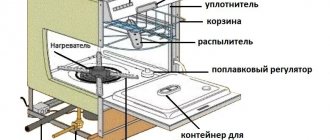A dishwasher is no longer a luxury in a modern kitchen. It allows housewives to save a lot of time and effort that is usually spent on washing dishes by hand. If a family consists of four or more people, then this technique will be considered a necessity. There are two main types of options on the market: built-in and freestanding dishwashers. It is difficult to say which of them is more popular, since each has strengths and weaknesses, as well as its own admirers.
What should you consider when purchasing?
When choosing a dishwasher, you have to face many difficulties, so it is important to know in advance what to look for when purchasing. If preference is given to a non-built-in model, then the choice may be influenced by both the size and appearance of the equipment. The material for the manufacture of such machines is stainless steel; they do not require a furniture facade, since they have their own and are installed on the floor under the kitchen countertop.
Dimensions
The dimensions of dishwashers have certain standards. They are divided into full-size, narrow and compact. The standard dimensions are 870*600*600 mm (height, width, depth) for full-size machines, and 870*450*600 mm for narrow ones. This doesn't mean there aren't other options. You can also purchase wider models, for example, 800 mm. Externally, such a dishwasher will be close to a square shape. The capacity of this equipment is very large - up to sixteen sets of dishes.
Narrow dishwashers, in particular non-built-in ones, allow you to load up to nine sets at a time. Compact models take up very little space, and they are designed to be placed on a countertop rather than on the floor. Their height varies from 450 to 470 mm. The disadvantages of such machines include the visibility of hoses and wires, as well as a small load of dishes. But for one or two people this option is quite acceptable. Even narrow or compact equipment can save significant amounts of water.
The choice of dimensions of a non-built-in dishwasher depends not only on the size of the family, but also on the area of the kitchen. In a small room, no matter how much you want, it is impossible to find a place for large equipment, especially free-standing ones, but the spacious interior will allow you to fantasize with objects as you like.
The best option for small and medium-sized kitchens is a narrow dishwasher. It will take up only 400-450 mm of kitchen space under the countertop, but at the same time it will cope with a fairly large volume of dishes.
Unlike full-size appliances, it uses less water, detergent and electricity.
Appearance
The design of a freestanding dishwasher matters a lot. Despite its dimensions, the appliances must meet modern standards, be stylish and fashionable, and highlight the interior of the kitchen. Manufacturers offer a wide selection of models that differ not only in color, but also in shape, as well as other external parameters.
Class
This designation is used for dishwashers to determine the consumption of electricity, water, and the quality of washing and drying. There are three classes: A, B, C. The A-class includes elite dishwashing equipment, which economically consumes electricity and water, and ideally copes with washing and drying dishes. B and C are significantly inferior in quality to class A and are being produced less and less often.
Connection to water supply
There are three types of connection methods to the water supply: cold water only, hot water, and both. The first option is preferable for both full-size and narrow dishwashers, because cold water is much cleaner than hot water. Some people prefer this type, despite the high energy consumption for heating. Connecting to hot water saves electricity, but prevents the equipment from functioning during periods of no hot water supply.
Dish tray
Most manufacturers use stainless steel to make dish trays. This is due to its high strength, resistance to corrosion, durability, and wear resistance.
Plastic containers are also used in manufacturing. They attract with their light weight and reduced price for both built-in and free-standing dishwashers.
The shape and size of the trays also matter. For convenience, containers should accommodate not only plates, but also large utensils such as pots and pans. You also need to make sure that there are small shelves for cutlery so that during the washing process, forks and spoons do not spill all over the machine. Some trays are quite functional. They fold, disassemble, remove and adjust - it is very convenient to use. Tray designs for narrow and full-size machines differ.
Dishwasher functionality
An important criterion for choosing a dishwasher is the set of certain functions. These include: washing programs, drying types, leakage protection system, noise level, as well as control and many other functions.
Washing programs
All built-in and free-standing dishwashers have several programs: gentle, moderate and intensive. The first is used for fragile dishes made of crystal, thin glass (glasses, wine glasses, vases, etc.), the water temperature during washing is 45-50 degrees. The moderate mode is suitable for daily use of any dishes, and the intensive mode will wash away the heaviest stains.
Some models have additional useful programs, such as: soaking in cold water, washing in economy mode, and automatically determining the degree of contamination.
The soaking program will allow you to leave the dishes to soak for some time from dried food residues, which can be easily removed with subsequent washing. Economy mode will use less water and electricity for lightly soiled dishes.
Drying types
There are also several types here: condensation, using fans and turbo drying. The first is the simplest and most time-consuming; it is used in more economical models. The liquid evaporates and exits through a special moisture receiver. The second type of drying is faster. Fans built into the body of the machine force air from the room inside, due to which the dishes dry out. Turbo drying is used for elite models; moisture evaporates due to the supply of hot air flow.
Leak protection system
This safety system is very important for any dishwasher. Thanks to special sensors built into the equipment, the water level and its overflow in the machine are monitored.
Noise level
All well-known manufacturers of dishwashing equipment equip them with various materials that reduce the noise of the operating appliance. This can be either special sound insulation of the walls of the machine, or pumps or motors with low noise levels. Naturally, the quieter the dishwasher is, the higher its cost.
Control
Two types of control are common: electronic and mechanical. The first has a number of advantages. Freestanding electronically controlled dishwashers have a stylish, modern design and many additional useful features, such as indicating the operating stage of the machine at the moment. But the price of such models is much higher than mechanical ones.
Dishwashers may also have other useful functions, such as ultraviolet sterilization of dishes, delay washing, timer, interior lighting of the machine, and others.
Main characteristics of dishwashers
1. Dimensions. Undercounter dishwashers mostly have standard width sizes of 45 and 60 cm and adjustable heights from 81 to 88 cm. There are also tabletop ones that are no larger than a large microwave.
2. Capacity. Basically, the number of sets that can be loaded is limited by the width of the machine. But there are manufacturers who, instead of, for example, the classic 11 sets for a standard 60 cm, design an internal space for 12.
How to choose dishwashers - capacity characteristics:
- tabletop - 4-5 sets;
- floor 45 cm – 8-9,
- floor 60 cm – 11-12.
Also, the completeness depends on such factors as a built-in unit or a free-standing one.
3. Number of programs. Of the main ones, the company does: washing too dirty dishes (pans, pots), quick wash, half load and crystal (ideal for glass products). Then there are additional variations with temperature conditions, duration and detergent consumption. Such modes are not the main ones, but sometimes they become favorites in some families.
It is worth understanding that: the more programming of washing options, the more expensive the device will be.
4. Energy saving. The energy saving class is indicated on all types of dishwashers. Leading manufacturers produce options A, A+ and higher. The higher the class, the lower the energy consumption.
5. Water saving. An important factor in a house where there are water meters.
6. Aquastop. A function in which the machine itself blocks the water supply in the event of a malfunction or any failure in electricity or liquid supply.
7. Saving detergent . Modern dishwashers are equipped with a function for adjusting the consumption of detergent during the dishwashing process. For premium cars, it is rated with the highest indicator – the letter A.
How does a dishwasher work?
To understand the principle of operation of dishwashing equipment, you can familiarize yourself with how it is designed. The required amount of water is drawn through a hose, connected at one end to the water supply and the other to a free-standing dishwasher. By the way, the hose may have additional protection against leaks. Then the water is heated and enters the working compartment. Detergent is also supplied, in portions, at a certain time. A mixture of water and detergent is sprayed onto the dishes in jets of varying intensity, thereby cleaning them. Before starting the machine, you should carefully check the load of plates and cutlery, as incorrect placement can lead to poor results.
Using a special pump, contaminated water is drained into the sewer. So, several washing cycles occur. Clean dishes are rinsed with cold water and dried. The drying process depends on its type: condensation, turbo or using fans.
Reliability and protection against leaks
Fears that a dishwasher can cause a flood and destroy kitchen furniture, drive away from yourself.
When choosing a model, pay attention to two important characteristics: the presence of a water leakage protection system and an internal stainless steel chamber. An internal chamber made of high-quality stainless steel is a guarantee that your dishwasher is protected from corrosion and will serve you for a long time.
A leakage protection system is a must in case of breakdown. If the hose suddenly bursts or the valve becomes clogged, the dishwasher will stop the program, notify you about this and prevent water from leaking outside the housing.
Tips for using your dishwasher
- Regular dishwasher detergents will not work as the process can create a lot of foam, which will lead to further problems with the machine.
- A chamber that is too crowded with dishes can cause ineffective washing. The result is unlikely to be positive.
- The dishes should be placed with the dirty side facing the spray arms, which are located in the central part of the machine. Do not place plates too close to each other.
- It is better not to wash steel and silver items together to avoid corrosion.
- Rinse aid is necessary for faster drying of dishes.
- If you load plastic products into the dishwasher, you should first make sure that they are resistant to high temperatures.
- To avoid clogging in the drain hose, remove large food debris from the dishes before loading.
A dishwasher in the house, narrow or full-size, is always a big plus. But in order for it to work properly, it is necessary to comply with certain requirements and operating rules described in the instructions. It is better to entrust the installation of dishwashers to specialists, especially if you do not have confidence in your own abilities.
In some cases, a freestanding dishwasher is not just a whim of the owners, but a real salvation. It is necessary if you have to wash mountains of dirty plates and pots every day. Its presence in the kitchen will save time and use it for more important and pleasant concerns.
Choosing the type of dishwasher depending on your kitchen
A good quality dishwasher is an expensive pleasure, so it often happens that it is purchased after repair. In this case, the space in the kitchen area is distributed, so you have to decide where to put the dishwasher in the finished kitchen. If you have such a situation, you need to choose the right machine model. They are:
- Fully built-in. These models are designed for installation inside one of the elements of the kitchen set, usually one of the cabinets.
- Partially built-in. They are installed in some cabinet models, saving space. Before purchasing such a machine, it is advisable to find out whether it is suitable for your headset.
- Classic full size. They are installed separately from the kitchen unit. Such models are very roomy, but they also take up a lot of space.
- Small and compact. Suitable for small kitchens, although they are not built into furniture, they still take up little space.
Having chosen equipment taking into account the characteristics of your kitchen, you can think about where to place the dishwasher. But remember that not only the dimensions of the dishwasher are important. Also take into account its power, water and electricity consumption (you have to pay for them!), maximum and minimum load. Compact models may not be suitable for a large family, and it is better not to take full-size ones for those who live alone, even if there is space in the kitchen.











